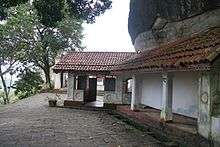Mulkirigala Raja Maha Vihara
| Mulkirigala Raja Maha Vihara මුල්කිරිගල රජ මහා විහාරය | |
|---|---|
 | |
 Shown within Sri Lanka | |
| Basic information | |
| Location | Mulkirigala , Sri Lanka |
| Geographic coordinates | 06°07′22.97″N 80°44′10.95″E / 6.1230472°N 80.7363750°ECoordinates: 06°07′22.97″N 80°44′10.95″E / 6.1230472°N 80.7363750°E |
| Affiliation | Buddhism |
| District | Hambantota |
| Province | Southern Province |
| Country | Sri Lanka |
| Heritage designation | Archaeological protected monument[1] (8 April 1988) |
| Architectural description | |
| Architectural type | Buddhist Temple |
| Architectural style | Cave temple |
| Founder | King Saddhatissa |
Mulkirigala Raja Maha Vihara (also known as Mulgirigala Raja Maha Vihara) (Sinhalese: මුල්කිරිගල රජමහා විහාරය) is an ancient Buddhist temple in Mulkirigala, Sri Lanka. It has been built on a 205 m (673 ft) high natural rock, surrounded with another four rocks known as Benagala, Kondagala, Bisogala and Seelawathiegala. The temple site is located about 2 km (1.2 mi) from the Mulkirigala junction and can be reached from either Dikwella or Tangalle towns. The temple has been formally recognised by the Government as an archaeological site in Sri Lanka. The designation was declared on 8 April 1988 under the government Gazette number 501.[2]
Name
Except its most common name Mulkirigala, the temple is also referred to as Mulgirigala, Muvathitigala, Muhudungiri and Dakkhina Vihara.[3] As the temple has been constructed on a massive natural rock similar to Sigiriya, the site is known as Punchi Seegiriya (Little Sigiriya) by the locals.
As mentioned in the Bodhi Vamsa chronicle, one of the temples known as Giriba Viharaya is where one of the Bo saplings out of 32 saplings germinated from Jaya Sri Maha Bodhi is planted, which was currently identified as Mulkirigala temple. During the Polonnaruwa period this temple was known as Samuddagiri Viharaya, according to the Kamburupitiya Wanaratna Thero, who had read the stone inscription of the pond.
In the 18th century the Mulkirigala rock was called as Adam’s Berg by the Dutch. It is believed that Europeans confused Mulkirigala with the Sri Pada (Adam’s Peak) and have believed tombs of Adam and Eve were located here.[4][3]
History
According to the ancient chronicle Mahavamsa, the Mulkirigala Vihara was constructed by King Saddhatissa in the third century.[4] After that the temple received royal patronage by numerous successive kings. During the 461-479 AD time period a Stupa was added to the temple by King Datusena and it was further developed by King Kirti Sri Rajasinghe (1747-1782).[5]
Temple layout

The site consists of seven viharas and has been constructed within five compounds known as Siyambalamaluwa, lower vihara compound, Bomaluwa, Rajamaha vihara compound, and upper Vihara compound.[6]
- Siyambalamaluwa, which comprises the museum, lower temple and the rest house.
- Lower Vihara compound consists of the Raja Maha Viharaya, tombs, Seemamalakaya, Monastery and Paduma Rahath Viharaya. Paduma Rahath Vihara contains the largest reclining Buddha image of the Vihara. There is also a small painted pagoda found inside the cave. Additionally an information centre has been established in this terrace.
- Bomaluwa, which consists mainly of the Vesak hall compound, Majjhima Nikaya cave (Bhanaka cave), Viharagal rock inscription (6-7 Century), and Bomaluwa (Bo tree terrace).
- The Raja Maha Vihara compound contains the Piriniwan Manchakaya, Raja Maha Viharaya, Aluth Viharaya, Naga Viharaya, pond, rock inscription (12 Century), lamp post and Diyagoda Etha Viharaya. A rock inscription found in this compound reveals the ancient name of the temple as Muhundgiri Vihara.[5]
- Dethispala Bodhiya, attendant Bodhiya, Garandi Kapolla, Chaitya, bell tower, pond and horizon valley can be seen in upper vihara compound. Dethispala Bodhiya is believed to be one of 32 sapling, brought from Anuradhapura where the original Jaya Sri Maha Bodhi is situated.[7]

Murals
A large collection of paintings and sculptures belonging to the Kandyan Era can be seen in the caves and image houses in the Vihara premises. Most paintings depict the episodes from the life of the Gautama Buddha and Jataka stories, such as Vessantara, Telapatta and Shivi.
See also
| Wikimedia Commons has media related to Mulkirigala Rock Temple. |
References
- ↑ "Protercted Monument List 2012-12-12" (PDF). Department of Archaeology. 12 December 2012. Retrieved 27 March 2016.
- ↑ "Gazette". The Gazette of the Democratic Socialist Republic of Sri Lanka. 501. 8 April 1988.
- 1 2 "The rock temple down south". Sunday Times. Retrieved 24 June 2015.
- 1 2 "Mulkirigala Raja Maha Viharaya – මුල්කිරිගල රජමහා විහාරය". amazinglanka. 3 February 2007. Retrieved 24 June 2015.
- 1 2 "Mulgirigala (Mulkirigala) rock monastery, Sri Lanka". mysrilankaholidays. Retrieved 24 June 2015.
- ↑ "Mulkirigala Temple-Southern Sri Lanka's magnificent Rock Temple Complex". srilankaview. Retrieved 24 June 2015.
- ↑ "Mulkirigala Rock Temple". elephanttravels. 13 September 2013. Retrieved 24 June 2015.
External links
- J.B.Disanayaka " Mulgirigala"- Sinhala Edition